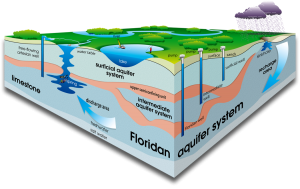From freshwater lakes to vast underground aquifers, central Florida has a wealth of water resources. Water sources can be split into groundwater and surface water.
Groundwater
Over 90% of Florida’s drinking water comes from underground aquifers. An aquifer is an underground system of porous rocks that holds water. The Floridan Aquifer is the largest aquifer in the southeastern United States — it is found beneath all of Florida and portions of Alabama, Georgia and South Carolina, and extends into the Gulf of Mexico and the Atlantic Ocean. Water within the aquifer is pumped, treated, and delivered to our homes and businesses as drinking water. Although the Floridan is a vast aquifer, it does not contain an unlimited supply of water. The aquifer has to be replenished by rainwater. When it rains, 60-75% of the rainwater evaporates into the atmosphere, leaving only a small portion to seep into the aquifer. On average, the Floridan aquifer is 1000 ft thick, so it can take a significant amount of time for the rainwater to make its way through the system to recharge the aquifer. If we use groundwater at a rate greater than the recharge rate, we will dry out the aquifer and be left without a critical source of drinking water.

Surface Water
There are over 50 named lakes in Osceola County alone. Lakes, streams, ponds, and rivers are valuable surface water sources. They provide critical habitat for plants and wildlife. They allow for recreation, fishing, and boating — all of which add a significant amount of money to our economy. Unfortunately, pollution threatens the health of these freshwater sources. As central Florida grows, there is an increase in impervious surfaces — roads, sidewalks, roofs, parking lots, etc.. When it rains, water runs off these hard surfaces and picks up pollutants such as fertilizer, pesticides, litter, pet waste, and vehicle fluids. This polluted water travels to a stormwater pond or other body of water. Water polluted with excess nutrients can lead to harmful algal blooms and a rapid growth of invasive plants — both of which can cause significant harm to the environment, economy, and human health.
 1
1
